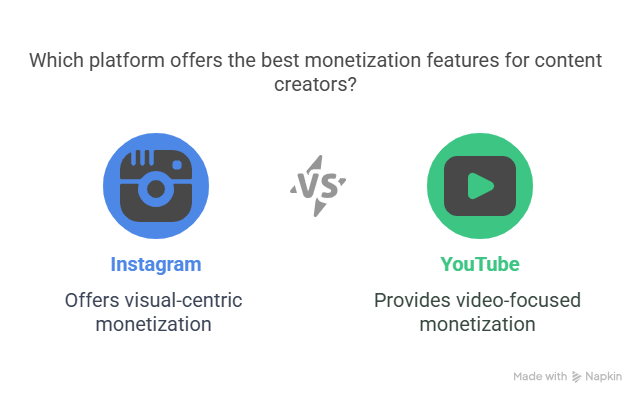The world of video content creation is booming, with platforms like Instagram and YouTube at the forefront. Did you know that the global digital video market is projected to reach $517.9 billion by 2027?
This surge is driven by social media marketing strategies that leverage engaging video content. Creators are now exploring new ways to monetize their influence, with paid video content emerging as a lucrative avenue. By utilizing platforms like Instagram and YouTube, creators can not only reach wider audiences but also generate significant revenue.
As we dive into the world of selling paid content, it’s essential to understand the dynamics of these platforms and how they can be harnessed for maximum profit.
Understanding Paid Content on Social Media Platforms
As social media continues to evolve, understanding how to monetize content on platforms like Instagram and YouTube is crucial for creators. The ability to earn revenue directly from their content allows creators to sustain and grow their presence online.
Both Instagram and YouTube offer unique features that enable creators to monetize their content. Understanding these features is key to maximizing earnings.

Instagram’s Monetization Features
Instagram provides several tools for creators to earn money, including Instagram Subscriptions and IGTV ads. Instagram Subscriptions allow fans to support their favorite creators with exclusive content, while IGTV ads enable creators to earn money from advertisements displayed on their IGTV videos.
Instagram’s features are designed to help creators build a closer relationship with their audience, providing exclusive content and experiences that foster a loyal community. By leveraging these features, creators can turn their passion into a sustainable career.
YouTube’s Revenue Generation Options
YouTube offers a range of monetization options, including Channel Memberships, Super Chat, and YouTube Premium revenue. Channel Memberships allow viewers to pay a monthly fee for exclusive content and badges, while Super Chat enables viewers to pay for their messages to be highlighted during live streams.
YouTube’s diverse revenue streams provide creators with multiple ways to earn money, from advertisements to direct support from their audience. By understanding and utilizing these options, creators can optimize their earnings on the platform.
Comparing Platform Policies and Requirements
While both Instagram and YouTube offer robust monetization features, their policies and requirements differ. For instance, YouTube requires creators to have at least 1,000 subscribers and 4,000 watch hours in the past 12 months to monetize their channel, whereas Instagram’s requirements focus more on engagement and content quality.
Understanding these differences is crucial for creators who want to maximize their revenue across both platforms. By tailoring their content and engagement strategies to each platform’s unique policies, creators can optimize their earnings and grow their audience effectively.
Step-by-Step Guide to Creating and Selling Premium Video Content
Monetizing your video content on social media platforms involves several key steps. To begin, it’s essential to understand your niche and target audience, as this will guide the type of content you create and how you market it.
Identifying Your Niche and Target Audience
Understanding your niche is crucial because it helps you create content that resonates with a specific audience. Influencer marketing often involves identifying a niche where you have expertise or a strong following.
To identify your target audience, consider factors such as age, interests, and engagement patterns on your content. This information will help you tailor your video content to meet their preferences.
Creating High-Quality Video Content
Producing high-quality video content is vital for attracting and retaining viewers. Invest in good camera equipment, editing software, and ensure that your videos are well-lit and have clear audio.
Consider the type of content that performs well on each platform. For example, Instagram favors short-form, engaging videos, while YouTube allows for longer, more in-depth content.
Setting Up Instagram Subscriptions and IGTV Series
Instagram offers several features to help creators monetize their content, including Subscriptions and IGTV Series. To set up Subscriptions, navigate to your Instagram profile, go to “Creator Tools,” and follow the prompts to enable Subscriptions.
For IGTV Series, plan your content in advance, as it allows you to post a series of videos that viewers can follow. This feature is great for promoted content that requires a narrative or tutorial approach.
Implementing YouTube Channel Memberships and Super Thanks
YouTube’s Channel Memberships allow viewers to pay a monthly fee for exclusive content and perks. To enable Channel Memberships, go to YouTube Studio, navigate to “Memberships,” and follow the setup process.
Super Thanks is another feature that allows viewers to show their appreciation for your content by making a one-time payment. It’s a way to earn money directly from your viewers.
Pricing Strategies for Maximum Profitability
Determining the right price for your premium content is crucial. Consider factors such as production costs, audience engagement, and market competition when setting your prices.
Experiment with different pricing models, and be prepared to adjust based on viewer feedback and sales data. The goal is to find a balance between profitability and viewer affordability.
Conclusion
Creating and selling paid video content on Instagram and YouTube can be a lucrative venture for content creators. By understanding the monetization features of these platforms, creators can diversify their income streams and maximize their earnings.
As discussed, Instagram’s paid content features, such as Subscriptions and IGTV Series, offer a range of opportunities for creators to earn money. Similarly, YouTube’s Channel Memberships and Super Thanks provide a way for creators to earn revenue from their loyal viewers.
Beyond paid video content, creators can also leverage pay-per-click advertising and social media sponsored content to further boost their earnings. By incorporating these strategies into their overall monetization plan, creators can ensure a steady stream of revenue from their social media presence.
By following the steps outlined in this article, creators can unlock the full potential of paid video content on Instagram and YouTube, and start building a successful and profitable online presence.
FAQ
What is paid content on social media, and how does it work?
Paid content on social media refers to the monetization of content through various features offered by platforms like Instagram and YouTube. Creators can earn money by producing exclusive content, such as IGTV series or YouTube Channel Memberships, that their audience pays to access.
How do I monetize my content on Instagram?
Instagram offers several monetization features, including Instagram Subscriptions and IGTV. To monetize your content, you need to meet Instagram’s requirements, such as having a certain number of followers, and then set up your account for monetization through the app’s settings.
What are YouTube Channel Memberships, and how can I use them?
YouTube Channel Memberships allow creators to earn money by offering exclusive content, badges, and other perks to their loyal viewers in exchange for a monthly fee. To use Channel Memberships, you need to be part of the YouTube Partner Program and meet the platform’s requirements.
How do I price my paid content for maximum profitability?
Pricing your paid content involves considering several factors, including production costs, audience engagement, and market competition. You should research your target audience’s willingness to pay and adjust your pricing strategy accordingly to maximize profitability.
Can I use both Instagram and YouTube to monetize my content?
Yes, you can use both Instagram and YouTube to monetize your content. In fact, diversifying your presence across multiple platforms can help you reach a broader audience and increase your revenue streams through various monetization features, including sponsored content and influencer marketing.
What is the role of influencer marketing in paid content on social media?
Influencer marketing plays a significant role in promoting paid content on social media. By partnering with influencers, creators can reach new audiences and drive traffic to their paid content, increasing their earning potential through platforms like Instagram and YouTube.
How does pay-per-click advertising work on social media?
Pay-per-click (PPC) advertising on social media involves creating ads that are displayed to users, and the advertiser is charged each time a user clicks on the ad. PPC can be an effective way to promote your paid content and drive traffic to your monetized channels or profiles.

